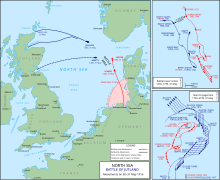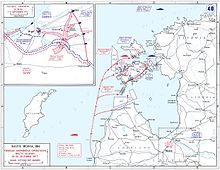SMS Markgraf
Along with her three sister ships, König, Grosser Kurfürst, and Kronprinz, Markgraf took part in most of the fleet actions during the war, including the Battle of Jutland on 31 May and 1 June 1916.
At Jutland, Markgraf was the third ship in the German line and heavily engaged by the opposing British Grand Fleet; she sustained five large-caliber hits and her crew suffered 23 casualties.
After Germany's defeat in the war and the signing of the Armistice in November 1918, Markgraf and most of the capital ships of the High Seas Fleet were interned by the Royal Navy in Scapa Flow.
[4] Markgraf was ordered under the provisional name Ersatz Weissenburg and built at the AG Weser shipyard in Bremen under construction number 186.
[10] In the aftermath of the loss of SMS Blücher at the Battle of Dogger Bank, Kaiser Wilhelm II removed Admiral Friedrich von Ingenohl from his post as fleet commander on 2 February.
[9] Vice Admiral Reinhard Scheer became commander in chief of the High Seas Fleet on 18 January 1916 when Pohl became too ill from liver cancer to continue in that post.
[12] Scheer proposed a more aggressive policy designed to force a confrontation with the British Grand Fleet; he received approval from the Kaiser in February.
[9] On 24 April, the battlecruisers of Rear Admiral Franz von Hipper's I Scouting Group conducted a raid on the English coast.
At this point, Scheer, who had been warned of the sortie of the Grand Fleet from its base in Scapa Flow, also withdrew to safer German waters.
[19] By this time, the German battlecruisers were steaming south to draw the British ships toward the main body of the High Seas Fleet.
[20] Markgraf and her two sisters fired their secondary guns on British destroyers attempting to make torpedo attacks against the German fleet.
[33] At the same time, Markgraf's secondary guns fired on the cruiser Warrior, which was seriously damaged by 15 heavy shells and forced to withdraw.
[42] Due to her reduced speed, Markgraf turned early in an attempt to maintain her place in the battle line; this, however, forced Grosser Kurfürst to fall out of formation.
But gunners aboard Grosser Kurfürst correctly identified the vessels as hostile and opened fire while turning away to avoid torpedoes, which prompted Markgraf to follow suit.
[48] The High Seas Fleet managed to punch through the British light forces without drawing the attention of Jellicoe's battleships, and subsequently reached Horns Reef by 04:00 on 1 June.
Due to the serious damage incurred by Seydlitz and Derfflinger at Jutland, the only battlecruisers available for the operation were Von der Tann and Moltke, which were joined by Markgraf, Grosser Kurfürst, and the new battleship Bayern.
Light forces were sent to recover the vessels, and III Squadron, which was in the North Sea en route to Wilhelmshaven, was ordered to cover them.
The Admiralstab (Navy High Command) planned an operation to seize the Baltic island of Ösel, and specifically the Russian gun batteries on the Sworbe Peninsula.
[56] On 18 September, the order was issued for a joint operation with the army to capture Ösel and Moon Islands; the primary naval component was to comprise the flagship, Moltke, along with III and IV Battle Squadrons of the High Seas Fleet.
[57] Opposing the Germans were the old Russian pre-dreadnoughts Slava and Tsesarevich, the armored cruisers Bayan, Admiral Makarov, and Diana, 26 destroyers, and several torpedo boats and gunboats.
The Irben Strait, the main southern entrance to the Gulf of Riga, was heavily mined and defended by a number of coastal artillery batteries.
On the 17th, Markgraf left Tagga Bay to rejoin her squadron in the Gulf of Riga, but early on the following morning she ran aground at the entrance to Kalkgrund.
Scheer—by now the Grand Admiral (Großadmiral) of the fleet—intended to inflict as much damage as possible on the British navy in order to obtain a better bargaining position for Germany, despite the expected casualties.
"[63] Following the capitulation of Germany in November 1918, most of the High Seas Fleet ships, under the command of Rear Admiral Ludwig von Reuter, were interned in the British naval base in Scapa Flow.
[62] Prior to the departure of the German fleet, Admiral Adolf von Trotha made clear to Reuter that he could not allow the Allies to seize the ships, under any conditions.
Reuter believed that the British intended to seize the German ships on 21 June 1919, which was the deadline for Germany to have signed the peace treaty.
On the morning of 21 June, the British fleet left Scapa Flow to conduct training maneuvers, and at 11:20 Reuter transmitted the order to his ships.
[4] The British soldiers in the guard detail panicked in their attempt to prevent the Germans from scuttling the ships;[67] they shot and killed Markgraf's captain, Walter Schumann, who was in a lifeboat,[8] and an enlisted man.
[71] In 2017, marine archaeologists from the Orkney Research Center for Archaeology conducted extensive surveys of Markgraf and nine other wrecks in the area, including six other German and three British warships.
[72] The wreck at some point came into the ownership of the firm Scapa Flow Salvage, which sold the rights to the vessel to Tommy Clark, a diving contractor, in 1981.







